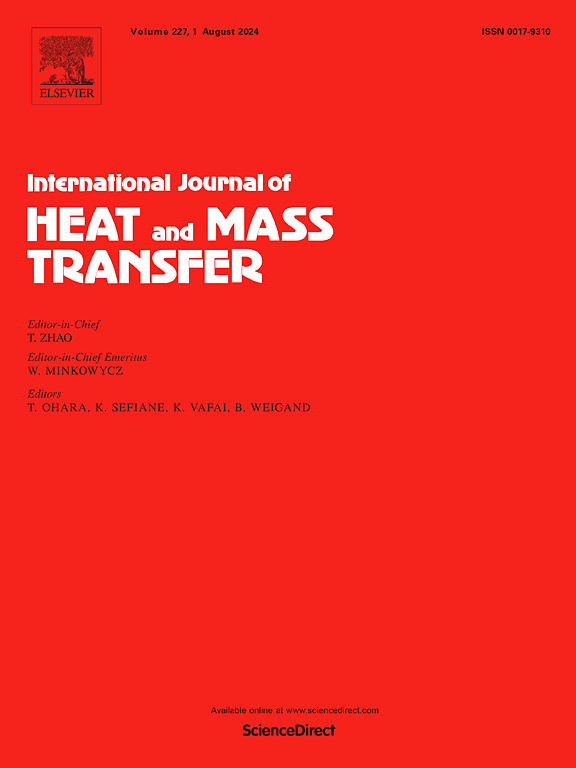Experimental study on natural convection frosting characteristics of vertical rib plates under different humidity and different materials
IF 5.8
2区 工程技术
Q1 ENGINEERING, MECHANICAL
International Journal of Heat and Mass Transfer
Pub Date : 2025-06-12
DOI:10.1016/j.ijheatmasstransfer.2025.127404
引用次数: 0
Abstract
To analyze the frosting characteristics of vertical rib plate (VRP) under natural convection conditions, the frosting process of VRP under different relative environmental humidity (REH) and different rib plate materials is experimentally studied by building a VRP frosting test bench. The following results are obtained by analyzing the frosting stage, frosting surface temperature (Tfs), frosting thickness (δ), dynamic frosting rate (v), and frosting surface roughness (Ra): The duration of each stage of frosting gradually shortens with the increase of REH. Under the same time conditions, the VRP of copper alloy has the lowest Tfs, and that of titanium alloy has the highest Tfs. The δ gradually increases with the enlargement of REH but the growth rate decreases. The δ at REH = 80% is 1.24, 1.22, and 1.15 times higher than that at REH = 50%, 60%, and 70%, respectively when frost branches intersect in adjacent VRP. Under different VRP material conditions, the v is the highest in copper alloy and the lowest in titanium alloy. There are significant differences in the shape of frost branches under different VRP materials, which are flaky in titanium alloy, and feathery in copper alloy and aluminum alloy. This is the main reason for the differences in Ra; Compared with the three materials, VRP has a significant frost suppression effect when it is the titanium alloy.
不同湿度、不同材料条件下垂直肋板自然对流结霜特性实验研究
为分析垂直肋板(VRP)在自然对流条件下的结霜特性,通过搭建垂直肋板结霜试验台,对不同相对环境湿度(REH)和不同肋板材料下的VRP结霜过程进行了实验研究。通过对结霜阶段、结霜表面温度(Tfs)、结霜厚度(δ)、动态结霜速率(v)、结霜表面粗糙度(Ra)的分析,得到如下结果:随着REH的增大,各阶段结霜持续时间逐渐缩短;在相同时间条件下,铜合金的VRP Tfs最低,钛合金的VRP Tfs最高。随着REH的增大,δ逐渐增大,但增长率减小。当相邻VRP中霜枝相交时,REH = 80%时的δ分别是REH = 50%、60%和70%时的1.24、1.22和1.15倍。在不同VRP材料条件下,铜合金的v值最高,钛合金的v值最低。不同VRP材料下霜枝形态差异显著,钛合金呈片状,铜合金和铝合金呈羽状。这是造成Ra差异的主要原因;与三种材料相比,VRP为钛合金时具有显著的抑霜效果。
本文章由计算机程序翻译,如有差异,请以英文原文为准。
求助全文
约1分钟内获得全文
求助全文
来源期刊
CiteScore
10.30
自引率
13.50%
发文量
1319
审稿时长
41 days
期刊介绍:
International Journal of Heat and Mass Transfer is the vehicle for the exchange of basic ideas in heat and mass transfer between research workers and engineers throughout the world. It focuses on both analytical and experimental research, with an emphasis on contributions which increase the basic understanding of transfer processes and their application to engineering problems.
Topics include:
-New methods of measuring and/or correlating transport-property data
-Energy engineering
-Environmental applications of heat and/or mass transfer

 求助内容:
求助内容: 应助结果提醒方式:
应助结果提醒方式:


